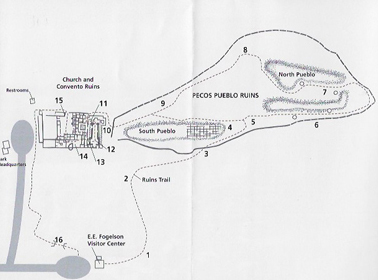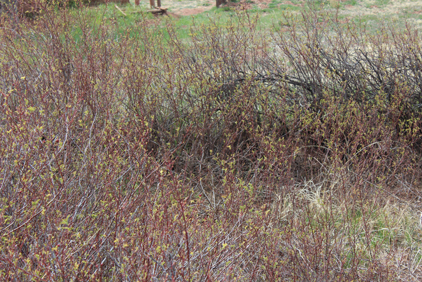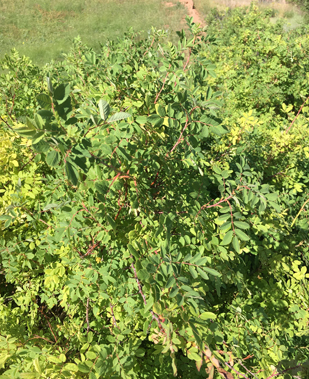
Location
Across path in front of church #10 (N35D33'00.191 X W105D41'22.392)
Flowers first observed: No flowers in 2017
Plants
 |
 |
Early Spring |
Summer |
Distribution
"Found along streams, in moist habitats, open ponderosa pine forests, slopes from 5,500-9,000 ft (1676-2743 m), flowers June-September. Distribution: Apache, Cochise, Coconino, Gila, Graham, Greenlee, Mohave, Navajo, Pima, Pinal, Yavapai, and Yuma counties; Canada, western U.S., northern Mexico." (SEINet)
Description
"Deciduous shrub, 1-3 m (3-10 ft) tall; thicket-forming; stems brown or gray, armed with straight or curved prickles, or unarmed; branches numerous. Leaves: Alternate, odd-pinnate with usually 5 to 7 leaflets, the leaflets oval to elliptic or obovate, 2-5 cm long, 1-2.5 cm wide, glabrous to puberulent or rarely glandular below, margins serrate; stipules leafy, arising from the base of the petiole. Flowers: Solitary or 2 to several, arranged in clusters at the ends of lateral branches; hypanthium 3-5 mm in diameter at time of flowering, glabrous; sepals 5, 1-2 cm long, glabrous to puberulent or occasionally glandular-stalked, the apex slightly expanded above the middle constriction, persistent; petals 5, 1-2.5 cm long, light pink to deep rose (rarely white); fragrant. Fruits: Hip enclosing the achenes, 0.6-1.5 cm long, rounded to ellipsoid, red-orange to purple or black; achenes numerous, 3-4 mm long." (SEINet)
Ethnobotanical Uses
"The hips are a good source of vitamin C and are consumed by birds, bears, and other animals, as well as humans. The hips can also be made into jelly and syrup and the roots make an orange dye. A poultice of various plant parts may be used for burns, boils, sores, cuts, and wounds. Branches have many ceremonial uses, and stems are used for basketry rims." (SEINet)
Internet Links